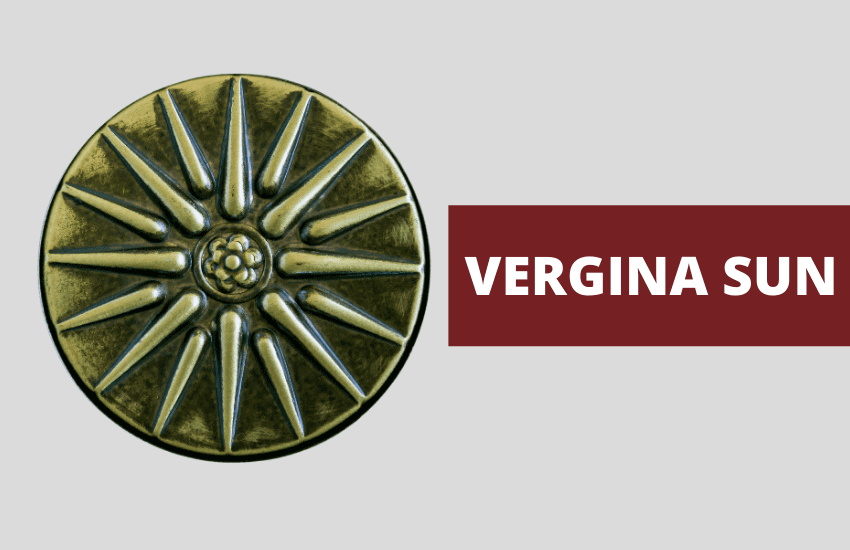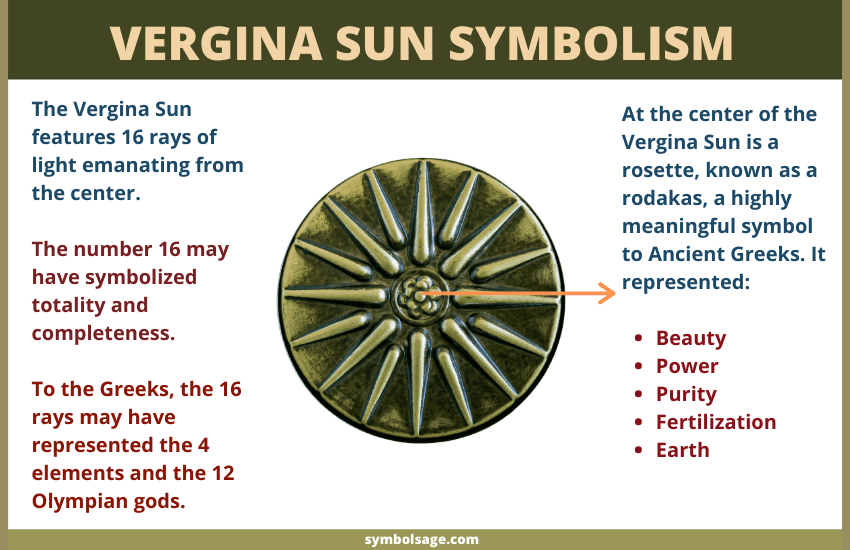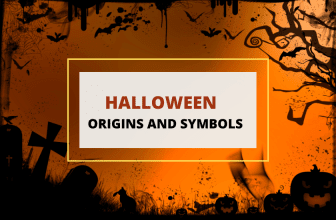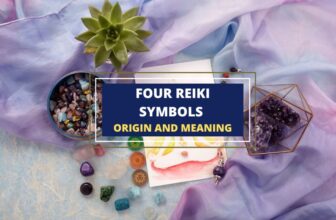
Table of Contents
Known as the Vergina Sun, the symbol of a stylized sun or star can be found on coins, walls, craters, vases, and visual arts from Ancient Greece. The symbol features sixteen rays of light emanating from a central rosette, known as a rodakas. The symbol was so popular at the time that Macedonians made it the official symbol and emblem of the Argead Dynasty, Macedon’s Royal House.
The Vergina Sun continues to be popular symbol and for many years, has been a source of dispute. Here’s a look at its origins, historical and symbolic significance.

Symbolism of the Vergina Sun
The Vergina Sun features sixteen rays of light radiating from a rodakas at its center. It’s a beautiful emblem and was commonly used as a decorative motif. The rodakas, or rosette, was a highly meaningful and respected symbol.
To the Ancient Greeks, it represented:
- Beauty
- Power
- Purity
- Fertilization
- Earth
Although other depictions of the legendary Vergina Sun only show it with 8 or 12 light rays, the oldest and most common versions always feature 16 rays. This is important because in many cultures, the number 16 is thought to symbolize completeness or totality.
As for the ancient Greeks, the rays of the Vergina Sun is said to represent the totality of all four elements (Water, Earth, Fire, and Air) along with the 12 major Olympian gods and goddesses. The complete attendance of the revered deities and the four elements of nature is said to be the source of completeness and is part of what makes this symbol a lucky one.

The Vergina Sun and the Macedonians – Creation Myth
Herodotus was able to preserve at least one legendary creation myth involving the Vergina Sun.
According to him, there were three ancestors from Argos who left their hometown to offer their services to the king of Illyria. Despite their pure intentions, the king harbored deep fear over their power, mostly because of a supposed omen which told him that the three men were destined for great things.
Overcome with paranoia, the king interpreted this omen to mean that the Argeons would someday take the throne for themselves. He cast the three men away from his kingdom without any compensation for the work they had already done tending to his flock.
Herodotus claims that as the three men were preparing to leave, the floor of the kingdom was suddenly illuminated with the rays of the sun, which had permeated the walls of the palace out of nowhere. As if to mark his rightful territory, the youngest Argeon drew out his sword, traced the image of the ‘sun’ onto the floor, cut the symbol out and stored it in his clothes.
The cut-out symbol was thought to have given the brothers from Argos great luck, since they found King Midas’ fruitful gardens almost as soon as they left the kingdom. It wasn’t long after that they created Macedonia and the Macedonian Dynasty.
Rise and Fall as a Public Symbol
In 1987, the Greek regions designed a solidarity flag that bore a golden Vergina Sun interposed on a blue background. The government thought the flag symbolized separatist efforts, so it was never promoted to official flag status. Nevertheless, some units of the Greek Armed Forces started integrating the Vergina Sun in their own flags.
Meanwhile, this design remained as the unofficial flag of Macedonia, until a spokesperson from the Greek Foreign Ministry claimed that the symbol was originally from Greece and that it had been stolen.
This controversy remained for several decades and was only put to rest in 2019, after the signing of the Prespa agreement wherein both countries agreed that the Vergina Sun will no longer be used as a public symbol in Macedonia’s territory.
Wrapping Up
The mere fact that two entire countries could not settle their respective claims to the Vergina Sun symbol for 27 long years demonstrates the importance of the Vergina Sun as a symbol and the positive values attached to it since the time of the Macedonian dynasty. Everyone craves completeness and totality, a rare trait that is fully embodied by the Vergina Sun.








